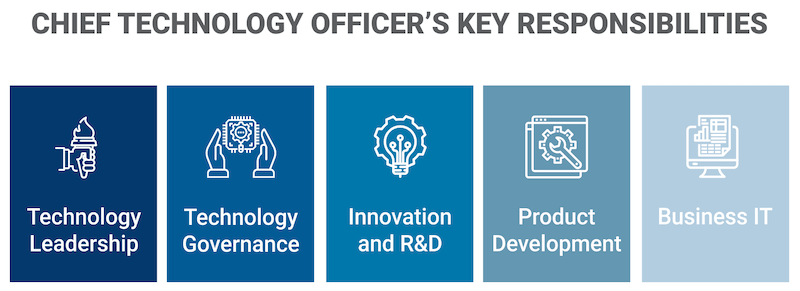Elevating Technology: CTO Expertise in Scaling from Startup to Enterprise
Table of Contents

- jaro education
- 4, March 2024
- 2:00 pm
Technology is the backbone of any modern business, and the role of the chief technology officer (CTO) is crucial for ensuring that the technology strategy aligns with the business goals. However, as a business grows from a startup to an enterprise, the challenges and expectations for the CTO also change dramatically.
In this blog, we will explore some of the key skills and competencies that a CTO needs to master in order to scale the technology organization and deliver value at every stage of growth. We will also share some insights and best practices from successful CTOs who have led their companies through various phases of transformation.
Who is a CTO?
The Chief Technology Officer (CTO) is the person in charge of handling the current technology and making rules about it in a company. A good CTO needs to know about business so they can make tech decisions that match the company’s goals. They don’t just fix tech problems; they also create, manage, and check the company’s tech resources. The main aim is to look at what the company needs in the short and long term and use money wisely to invest in things that help the company reach its goals.
Sometimes, the CTO job is similar to other roles, like the Chief Information Officer (CIO) or Chief Science Officer. It depends on how big the company is and what it focuses on. In some places, the CTO might manage the infrastructure, plan strategies, or work with customers. The exact tasks of a CTO can be different for each company, but usually, they report to the CEO. CTOs are important in the C-suite (the top-level executives of a company) because they’re often in positions where they can bring in new innovations in technical aspect. They help organizations become more efficient and perform better by using new tools.
The responsibilities of a Chief Technology Officer (CTO) often encompass a range of roles, typically categorized into the following four areas:

*harbott.com
Infrastructure Management
CTOs serve as infrastructure managers and are tasked with overseeing data, security, network, and maintenance aspects. In addition to these responsibilities, they play a crucial role in implementing the technical strategy and technological roadmaps of their organizations.
Strategic Planning
CTOs function as strategic planners and are responsible for executing the technical strategy of the organization and contributing to the development of new business strategies.
Consumer Liaison
CTOs in this role concentrate on delivering projects that align with customer needs. Their duties extend to managing customer relations, comprehending target markets, and facilitating the successful delivery of IT projects to the market.
Strategic Thinking
CTOs act as strategic thinkers and are engaged in developing corporate strategies and business models. They analyze various target markets to inform decision-making and contribute to the overall growth and success of the organization.
To fulfill these roles requires a huge skill set and leadership mindset. You can learn these skill sets with the Chief Technology Officer Program Offered by CEP, IIT Delhi. It is designed to provide professionals with the knowledge and skills needed to succeed in crucial roles. It improves leadership abilities in technology strategy, innovation, and decision-making, effectively connecting business and IT functions. This program enables CTOs to coordinate technology efforts with organizational objectives and lead digital transformation.
Challenges Startups Face on its Way to Becoming Enterprise
As young companies grow, they face issues like not having enough resources, dealing with tech problems as they get bigger, and figuring out how to manage their teams. In this discussion, we’ll take a closer look at the common obstacles startups face on their way to becoming bigger businesses:
Access to Finance
Startups face challenges in securing funds to initiate and expand their business, encountering difficulties in obtaining loans or investments.
Lack of Planning
Successful startups require a clear vision, mission, and strategy covering key areas like sales, development, and funding. A lack of comprehensive planning can hinder their progress.
Hiring the Right Talent
Attracting and retaining skilled employees is crucial for startups to achieve their goals, presenting an ongoing challenge in building a talented and passionate team.
Effective Marketing on a Limited Budget
Startups need to reach their target customers, but limited resources and time make effective marketing a challenging aspect of their operations.
Attracting Customers
Creating a unique value proposition and differentiation from competitors is vital for startups to convince customers to choose their products or services.
Making Decisions
Startups often need to make quick and informed decisions with incomplete or conflicting information, a challenging aspect of their decision-making process.
Time Management
Prioritizing and managing time effectively is critical for startups, who must balance personal and professional lives while ensuring productivity.
Competition
Startups must navigate existing and potential competitors, staying ahead of market trends and customer needs to establish a sustainable position.
Scaling the Business
Growing and expanding market share presents challenges for startups, including maintaining quality, preserving company culture, and ensuring customer satisfaction.
Legal and Regulatory Compliance
Startups need to comply with industry and location-specific laws and regulations, safeguarding intellectual property and data while ensuring legal compliance.
Managing Cash Flow
Monitoring and controlling income and expenses is a constant concern for startups, ensuring they have enough cash to operate and invest in their growth.
How CTO can Resolve the Challenges Startup Face During Scaling Up
Scaling up is a common challenge for startups, especially in the tech industry. A CTO can lead the technological development and innovation of a startup, as well as manage the team and resources. Here are some tips on how a CTO can resolve the challenges startups face during scaling up:
Organizational Structure
Developing a well-defined organizational structure before it becomes an urgent necessity is crucial for a scaling startup. This includes outlining roles, responsibilities, and communication channels to establish an efficient framework. A forward-thinking CTO should design a structure capable of accommodating the evolving needs and goals of the startup, ensuring a smooth transition during periods of growth.
Delegation Skills
The ability to delegate effectively is a key skill for a CTO in a scaling startup. While the temptation to be hands-on in every aspect of product development may be strong, learning to trust and empower the team is essential to prevent burnout and foster efficiency. By delegating non-essential tasks and decisions, the CTO can focus on the strategic vision, allowing the team to thrive independently.
Autonomy and Ownership
Fostering a culture of autonomy and ownership among team members is vital for a CTO guiding a startup through scaling challenges. By avoiding micromanagement and interference, the CTO empowers the team, boosting motivation, creativity, and productivity. Cultivating an environment where team members take ownership of their work reduces dependency on the CTO, contributing to a more agile and self-sufficient organization.
Effective Communication
In the journey of scaling up, effective communication is paramount for a CTO. The ability to convey messages clearly and concisely to the team, stakeholders, and customers is essential. Avoiding unnecessary information, focusing on key messages and goals, and actively listening and soliciting feedback contribute to an environment of open and productive communication. By ensuring effective communication, a CTO facilitates a shared understanding of objectives and fosters a collaborative and responsive team culture.
Team Management
As the startup grows, team management becomes a critical responsibility for the CTO. Involvement in hiring, ensuring the right skills and fit for the startup, and providing ongoing guidance and support are key aspects. Actively mentoring the team members, recognizing their achievements, and addressing any issues or conflicts that may arise are integral to maintaining a motivated and cohesive team. The CTO’s leadership in team management plays a pivotal role in sustaining a positive and productive work environment.
Technical Direction and Strategy
Setting the technical direction and strategy is a cornerstone for a CTO steering a startup through the scaling process. Having a clear vision and roadmap for product development aligned with the startup’s mission and values is essential. Choosing an appropriate tech stack, software, and hardware that are scalable, secure, and reliable ensures the foundation for growth. Continuous monitoring, evaluation of product performance, and the implementation of improvements and innovations contribute to the sustained success of the startup’s technical endeavors.
What is the Difference Between a Startup CTO and an Enterprise CTO
A startup CTO needs to be more agile and adaptable to changing customer needs and market conditions, while an enterprise CTO needs to be more stable and consistent in delivering quality and reliability. That’s why it is crucial to know the difference between them so any business can make the right decision. Here is a table to explain how a Startup CTO is different from an enterprise CTO.
| Aspect | Startup CTO | CTO at a Large Company |
|---|---|---|
| Responsibilities | More hands-on, involved in day-to-day operations | Focus on long-term strategic planning and management |
| Work Environment | Fast-paced, rapidly changing | More stable and structured |
| Resource Management | Requires resourcefulness and creativity | Deals with larger resources and established processes |
| Team Management | Manages smaller, agile teams | Manages larger teams with complex organizational structures |
| Focus on Innovation | Emphasis on agility and innovation | Balances innovation with stability and scalability |
| Adaptability | Must thrive in uncertainty and change | Navigates complex organizational dynamics |
| Technical Expertise | Strong technical skills and hands-on experience | Strong technical skills with a strategic focus |
| Leadership Skills | Inspires and leads smaller, dynamic teams | Manages and leads larger, diverse teams |
Real-World Examples of Successful Scaling Under CTO Leadership
Here are some of the companies and their CTOs that have achieved impressive growth and innovation:
1. Netflix
Mike Kail was the CTO of Netflix from 2011 to 2014, and he helped the company scale its streaming service to millions of users worldwide. He also led the migration of Netflix’s infrastructure to the cloud, which improved performance, reliability, and security.
2. Spotify
Gustav Söderström has been the CTO of Spotify since 2012, and he oversees the engineering, product, design, and data teams that power the music streaming platform. He has been instrumental in scaling Spotify’s user base to over 300 million monthly active users, as well as launching new features such as podcasts, videos, and personalized recommendations.
3. Shopify
Jean-Michel Lemieux has been the CTO of Shopify since 2015, and he is responsible for the technical vision and strategy of the e-commerce giant. He has led the development of Shopify’s platform, which enables over one million merchants to sell online, in-store, and on social media. He has also fostered a culture of innovation and experimentation, which has resulted in products such as Shopify Plus, Shopify Payments, and Shopify Fulfillment Network.
4. Duolingo
The language learning app has rapidly expanded its course offerings and user base with a team of fewer than 40 people. The CTO, Severin Hacker, has built a culture of experimentation and data-driven decision-making, leveraging the power of the community to create and test new content.
5. Akamai
The internet infrastructure company has grown from a small startup to a global leader in content delivery and cloud services. The CTO, Tom Leighton, has overseen the development of a scalable and resilient platform that handles over 30% of the world’s web traffic. He has also fostered a culture of innovation and collaboration, encouraging engineers to pursue their own ideas and projects.
6. Stripe
The online payment platform has scaled from a few lines of code to a billion-dollar company that powers millions of businesses worldwide. The CTO, Greg Brockman, has led the engineering team to build a robust and flexible API that enables developers to integrate Stripe into their applications with ease. He has also championed a culture of learning and feedback, creating a system of peer reviews and mentorship.
7. Slack
The workplace communication tool has grown from a side project to a dominant player in the enterprise software market. The CTO, Cal Henderson, has managed the engineering team to deliver a fast and reliable service that supports over 10 million daily active users. He has also cultivated a culture of empathy and diversity, hiring engineers from different backgrounds and perspectives
Conclusion
The role of a CTO is not static but evolves along with the company’s growth and challenges. From being a hands-on developer and co-founder in a startup to becoming a strategic leader and manager in a large enterprise, a CTO needs to adapt to the changing demands of the business and the technology. A successful CTO must possess a broad range of skills, such as technical expertise, leadership, communication, innovation, and cultural sensitivity.
A CTO must also be able to build bridges, not only products or services, with internal and external stakeholders, and foster a culture of learning and collaboration within the organization. By following the best practices and lessons learned from other experts who have gone through the journey, a CTO can elevate the technology and the business to new heights.
Frequently Asked Questions
Cybercriminals are continuously improving their attacking abilities with the help of AI. Now they are launching large-scale attacks by integrating AI technologies into their workflows. To prevent these attacks, you should utilise AI to analyse large volumes of data, reducing false positives from security alerts and cutting out bottlenecks from security alerts.
The major benefits of AI-based cybersecurity include –
- Quickly analysing large volumes of data
- Automating the repetitive cybersecurity tasks
- Predicting potential attacks and providing messages to the security teams
To become a professional in AI cybersecurity, you need knowledge about ML data modelling, language modelling, behaviour analysis, and deep neural networks. For cybersecurity, you need a clear understanding of network security, cryptography, malware detection, data protection, and computer forensics.
No, AI can perform specific tasks in cybersecurity, but it can’t completely replace human input.
Yes, the cybersecurity professionals can automate the mundane tasks with the help of AI.
Programme on Strategic Management
Programme on Strategic Management
Programme on Strategic Management
Programme on Strategic Management
Programme on Strategic Management
Programme on Strategic Management
Programme on Strategic Management






